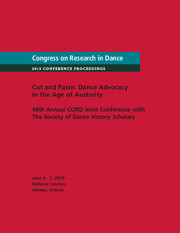Article contents
Music and Theory: Reflecting on Outcomes-Based Assessment
Published online by Cambridge University Press: 04 January 2013
Extract
I once read that the music we listen to during our high school and college years is the music that most resonates with us throughout our lifespan. I would suggest as well that the theory we encounter during a doctoral program will continue to resonate throughout our professional lives. This certainly has been true for me, and, in my case, there is congruence between the music and the theory, making for an even deeper attachment. In this presentation I will explore that attachment and also question it, giving voice to conflicting arguments and trying to resolve them. The internal dialogue made audible here was generated by the current intense focus on outcomes-based assessment in education.
- Type
- Panel: Critical Issues in Pedagogy and Research: Perspectives on Dance Education Theory and Practice
- Information
- Copyright
- Copyright © The Author(s) 2009
References
Works Cited
- 1
- Cited by


